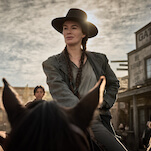Hedebrant has another new neighbor in Ragnar's apartment, 12-year-old Lina Leandersson, who introduces herself to Hedebrant with the words, "I can't be your friend," then proceeds to spend every evening with him in the halfhearted park outside their apartment complex. Sometimes she smells bad and looks haggard. At other moments, she looks like a girl in the flush of youth. Meanwhile, residents keep disappearing, and Hedebrant starts to put two and two together about why he never sees his new friend in daylight.
The "v" word only gets mentioned briefly in Let The Right One In, which is fitting, since vampirism is used more to support the film's themes than to provide traditional scary-movie thrills. When director Tomas Alfredson, working from a novel and screenplay by John Ajvide Lindqvist, does go for bloodsucking jolts, they're effective, but the quieter moments are what make the movie heartwarming and unsettling. As Hedebrant and Leandersson's friendship deepens, the film makes it impossible to judge whether we're watching tender scenes of puppy love or unholy union. And when an emboldened Hedebrant fights back against his bullies, we see the grave consequences of his newfound assertiveness.
Let The Right One In is more concerned with the everyday horrors of childhood than things that go bump—or that growl and tear—in the night. Directing with a controlled chilliness in sync with his snowy setting, Alfredson keeps his protagonist vulnerable while slowly letting him regain his self-respect and capacity for friendship, developments the film uncomfortably link to his potential for violence. It's a sweetly queasy film that suggests the spirit that sustains us, the demons we hide from the world, and the monsters that prey upon us in the dark might all be variations on the same beast.









































